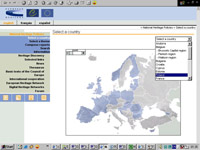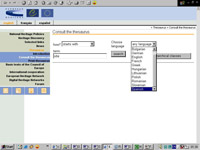
Figure 10: European Heritage Network: selection of policy reports by country
HEREIN - The European Heritage Network, initiated by the Council of Europe in 1997, was the first project co-financed by the Council of Europe and the European Commission (2002-2003). It aimed to gather a database on cultural heritage policy in European countries through a network of national correspondents, using a questionnaire, to publish this information online and update it annually, to promote access to cultural heritage through virtual exhibitions and a calendar of events (Figure 10).

Figure 10: European Heritage Network: selection of policy reports by country
The multilingual thesaurus developed as part of the HEREIN project plays the role of a terminological standard for national policies dealing with architectural and archaeological heritage, as defined in the European Conventions of Granada (October 1985) and Valletta (January 1992). The multilingual thesaurus was planned as a tool to help users of the European Heritage Network website to locate certain topics in the online national reports. The reports are published in English or French (the official languages of the Council of Europe), a version in the national language being optional. The terms of the thesaurus were used as descriptors to index the thematic chapters of the cultural policy reports. By selecting any term, in any language included in the thesaurus, the user could find the information more easily. The multilingual thesaurus was meant to facilitate access to different national experiences or policies across Europe, no matter how diverse, while the scope notes attached to the terms helped to contribute to a better understanding of those concepts.
During the first stage the team produced a draft thesaurus of about 500 terms in three languages: English, French and Spanish. The thesaurus was extended to other languages during a second stage (2002-2003): Bulgarian, Hungarian, Polish, Romanian, on the basis of the interest of the national correspondents of those countries. Later on, other member countries in this network expressed interest in adding a national version: Lithuania, Cyprus, Slovenia and Germany.
This thesaurus differs from the ISO 5964:1985 standard 'Guidelines for the establishment and development of multilingual thesauri' in that it did not choose a source language. When building the thesaurus, this implied a constant exchange between languages, so as to review concepts, their translations and their relationships. Most of the terms in the thesaurus come from reports on cultural heritage policy in Europe. Each term selected from the reports was placed into the most relevant class:
| Group no. | Category | Sub-categories |
|---|---|---|
| 1 | Agents | (administration, organisations, agents) |
| 2 | Heritage category | (cultural property, areas, heritage interest, heritage) |
| 3 | Documentation systems | (documentation, inventories, list of protected property) |
| 4 | Legal systems | (legal instruments, planning system, heritage management, property, unlawful acts) |
| 5 | Interventions | (intervention types, policy, programmes, tools) |
| 6 | Professional training, skills and qualifications | (professions, skills, training) |
| 7 | Access and interpretation | (access and interpretation) |
| 8 | Economic and financial systems | |
| 9 | Broad concepts |
The work of the countries' representatives was to establish the linguistic equivalence relationships in the different languages:
For instance, 'Crown property' is a term found only in Great Britain and Spain; 'listed buildings' will have two categories in French: 'edifice énscrit' and 'edifice classé'. Within each class, terms were ordered following the same hierarchical relationship for all linguistic versions of the thesaurus. Poly-hierarchies were accepted: for instance, 'castle' is subordinated to 'Defence' but also to 'Domestic'. Terms regarded as too specific to one language or terms which corresponded to regional peculiarities were treated as equivalent terms to a concept common to all the languages. The work required a lot of correspondence and face to face meetings among the teams, made up of translators, archaeologists, cultural heritage administrators and editors.
Unfortunately, the thesaurus of cultural policy terms was not implemented as planned. It is a subsidiary tool of the network. The lack of financing from the Council of Europe and the European Commission to continue the project stopped the next stage, which was to index the report using the thesaurus and its implementation as a multilingual retrieval mechanism. Because the time and resources were underestimated, dedicated software for the development and maintenance of the multilingual thesaurus, developed by Adlib, was not ready until after the end of the project (June 2003). For a whole year, the representatives of partner countries compiled the thesaurus using a basic Access database and Word documents, which caused delays and redundancies. There was no time to test the dedicated software and errors remain to be solved in the indefinite future. Still, the Thesaurus for Cultural Policy Terms is a valuable tool as such, available online as a resource bridging several languages for a very specific area of interest. The thesaurus can be either consulted online on the website of the European Heritage Network or in print (hierarchically or alphabetically), in one language or as a whole (Figure 11).

Figure 11: European heritage network: Thesaurus search choosing language
© Internet Archaeology/Author(s)
University of York legal statements | Terms and Conditions
| File last updated: Tue Sep 27 2005